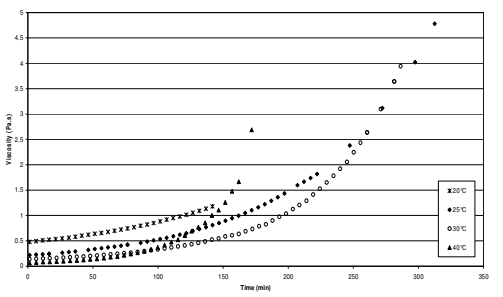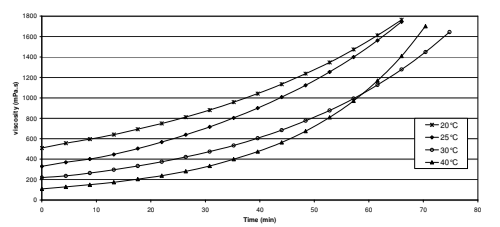Enhanced TDS
Identification & Functionality
- Chemical Family
- RTU Product Type
- Technologies
- Product Families
Features & Benefits
- Ready-to-Use Product Features
- Product Features
- Laminating system with low viscosity and high flexibility.
- The reactivity of this system can be adjusted on demand.
- The systems are qualified by Germanischer Lloyd.
Applications & Uses
- Composites Processing Methods
- Product End Uses
- Markets
- Applications
- Processing Information
- Infusion
- Resin Transfer Moulding
- Wet lay-up
- Filament Winding
Regulatory & Compliance
- Certifications & Compliance
Technical Details & Test Data
- Processing Information
Viscosity Build up : (Rhemoeter AGR2, plate/plate 25 mm, 100 rpm)

Viscosity Build Up (Rhemoeter Agr2, Plate/Plate 25 Mm, 100 Rpm)

Viscosity Build Up (Rhemoeter Agr2, Plate/Plate 25 Mm, 100 Rpm)
Properties of The Cured, Neat Formulation
Property LY1568/Aradur 3489 LY1568/Aradur 3492 Unit Test Method Condition Glass Transition Temperature (Tg) 61 - 65 74 - 78 °C ISO 11357-2, DSC, 10 K/MIN 15 h 50°C Glass Transition Temperature (Tg) 75 - 78 79 - 85 °C ISO 11357-2, DSC, 10 K/MIN 6 h 70°C Glass Transition Temperature (Tg) 76 - 79 78 - 83 °C ISO 11357-2, DSC, 10 K/MIN 4 h 80°C Glass Transition Temperature (Tg) 77 - 80 78 - 83 °C ISO 11357-2, DSC, 10 K/MIN 8 h 80°C Glass Transition Temperature (Tg) 78 - 82 79 - 83 °C ISO 11357-2, DSC, 10 K/MIN 2 h 100°C Glass Transition Temperature (Tg) 79 - 83 80 - 84 °C ISO 11357-2, DSC, 10 K/MIN 5 h 100°C Glass Transition Temperature (Tg) 80 - 84 78 - 82 °C ISO 11357-2, DSC, 10 K/MIN 1 h 120°C Tensile Strength 67 - 71 65 - 70 MPa ISO 527 8 h 80°C Elongation at Tensile Strength 4.4 - 5.0 4.4 - 4.7 % ISO 527 8 h 80°C Ultimate Strength 54 - 58 58 - 62 MPa ISO 527 8 h 80°C Ultimate Elongation 10.5 - 11.0 7.0 - 9.0 % ISO 527 8 h 80°C Tensile Modulus 2850 - 3000 3100 - 3300 MPa ISO 527 8 h 80°C Flexural Strength 120 - 130 125 - 135 MPa ISO 178 8 h 80°C Elongation at Flexural Strength 5.5 - 6.5 5.8 - 6.4 % ISO 178 8 h 80°C Ultimate Strength 100 - 115 120 - 130 MPa ISO 178 8 h 80°C Ultimate Elongation 9.0 - 10.0 7.0 - 7.5 % ISO 178 8 h 80°C Flexural Modulus 2910 - 3010 2900 - 3100 MPa ISO 178 8 h 80°C Fracture Toughness (K1C) 0.7 - 0.8 0.7 - 0.8 MPa√m ISO 13586 8 h 80°C Fracture Energy (G1C) 170 - 210 210 - 230 J/m² ISO 13586 8 h 80°C Property LY1568/Aradur 3489 LY1568/Aradur 3492 Unit Test Method Condition Shear Strength 53 - 59 55 - 61 MPa ASTM D 2344 8h 80°C Note
- Short beam: Laminate comprising 12 layers unidirectional
- E-glass fabric (425 g/m²)
- Laminate thickness t = 3.0 - 3.2 mm
- Fibre volume content: 63 - 65 %
Processing Guidelines
- We recommend that the components are weighed with an accurate balance to prevent mixing inaccuracies which can affect the properties of the matrix system. The components should be mixed thoroughly to ensure homogeneity. It is important that the side and the bottom of the vessel are incorporated into the mixing process.
- When processing large quantities of mixture the pot life will decrease due to exothermic reaction. It is advisable to divide large mixes into several smaller containers.
- Properties of The Cured, Neat Formulation
Property LY1568/Aradur 3489 LY1568/Aradur 3492 Unit Test Method Condition Glass Transition Temperature (Tg) 61 - 65 74 - 78 °C ISO 11357-2, DSC, 10 K/MIN 15 h 50°C Glass Transition Temperature (Tg) 75 - 78 79 - 85 °C ISO 11357-2, DSC, 10 K/MIN 6 h 70°C Glass Transition Temperature (Tg) 76 - 79 78 - 83 °C ISO 11357-2, DSC, 10 K/MIN 4 h 80°C Glass Transition Temperature (Tg) 77 - 80 78 - 83 °C ISO 11357-2, DSC, 10 K/MIN 8 h 80°C Glass Transition Temperature (Tg) 78 - 82 79 - 83 °C ISO 11357-2, DSC, 10 K/MIN 2 h 100°C Glass Transition Temperature (Tg) 79 - 83 80 - 84 °C ISO 11357-2, DSC, 10 K/MIN 5 h 100°C Glass Transition Temperature (Tg) 80 - 84 78 - 82 °C ISO 11357-2, DSC, 10 K/MIN 1 h 120°C Tensile Strength 67 - 71 65 - 70 MPa ISO 527 8 h 80°C Elongation at Tensile Strength 4.4 - 5.0 4.4 - 4.7 % ISO 527 8 h 80°C Ultimate Strength 54 - 58 58 - 62 MPa ISO 527 8 h 80°C Ultimate Elongation 10.5 - 11.0 7.0 - 9.0 % ISO 527 8 h 80°C Tensile Modulus 2850 - 3000 3100 - 3300 MPa ISO 527 8 h 80°C Flexural Strength 120 - 130 125 - 135 MPa ISO 178 8 h 80°C Elongation at Flexural Strength 5.5 - 6.5 5.8 - 6.4 % ISO 178 8 h 80°C Ultimate Strength 100 - 115 120 - 130 MPa ISO 178 8 h 80°C Ultimate Elongation 9.0 - 10.0 7.0 - 7.5 % ISO 178 8 h 80°C Flexural Modulus 2910 - 3010 2900 - 3100 MPa ISO 178 8 h 80°C Fracture Toughness (K1C) 0.7 - 0.8 0.7 - 0.8 MPa√m ISO 13586 8 h 80°C Fracture Energy (G1C) 170 - 210 210 - 230 J/m² ISO 13586 8 h 80°C - Properties of The Cured, Reinforced Formulation
Property LY1568/Aradur 3489 LY1568/Aradur 3492 Unit Test Method Condition Shear Strength 53 - 59 55 - 61 MPa ASTM D 2344 8h 80°C Note
- Short beam: Laminate comprising 12 layers unidirectional
- E-glass fabric (425 g/m2)
- Laminate thickness t = 3.0 - 3.2 mm
- Fibre volume content: 63 - 65 %
- Viscosity Build Up (Rhemoeter Agr2, Plate/Plate 25 Mm, 100 Rpm)

Safety & Health
- First Aid Information
- Contamination of the eyes by resin, hardener or mix should be treated immediately by flushing with clean, running water for 10 to 15 minutes.
- A doctor should then be consulted. Material smeared or splashed on the skin should be dabbed off, and the contaminated area then washed and treated with a cleansing cream (see above).
- A doctor should be consulted in the event of severe irritation or burns.
- Contaminated clothing should be changed immediately. Anyone taken ill after inhaling vapours should be moved out of doors immediately. In all cases of doubt call for medical assistance.
Storage & Handling
- Storage Conditions
- Provided that Araldite® LY 1568 and Aradur® 3489 or Aradur® 3492 are stored in a dry place in their original, properly closed containers at the storage temperatures mentioned in the MSDS they will have the shelf lives indicated on the labels.
- Partly emptied containers should be closed immediately after use.
- Handling Information
Protective clothing
Yes Gloves Essential Arm protector Recommended when skin contact likely
Goggestery diasses
Yes Respirator/dust mask
Recommended Skin protection before starting work
Apply barrier cream to exposed skin
Skin protection after washing
Apply barrier or nourishing cream
Skin protection cleansing of contaminated skin
Dab off with absorbent paper, wash with warm water and alkali-free soap, then dry with disposable towels. Do not use solvents
Clean shop requirements
Cover workbenches, etc. with light coloured paper. Use disposable breakers, etc.
Disposal of spillage
Soak up with sawdust or cotton waste and deposit in plastic-lined bin
Ventilation: of workshop
Renew air 3 to 5 times an hour
Ventilation: of workplace
Exhaust fans. Operatives should avoid inhaling vapours.
